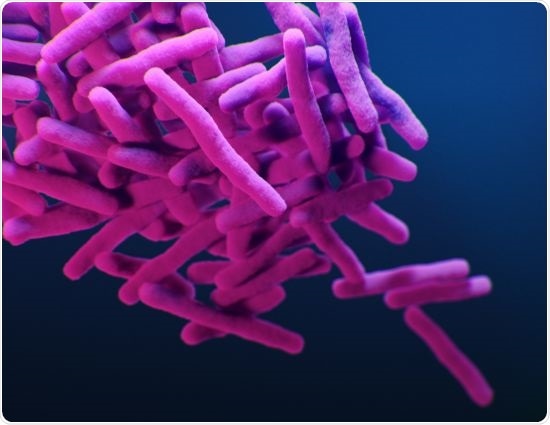A novel technology that integrates machine learning and high-throughput imaging could accelerate drug discovery to fight tuberculosis (TB).

A medical illustration of drug-resistant, Mycobacterium tuberculosis bacteria. Image Credit: CDC/Alissa Eckert; James Archer.
For generations, TB has killed more individuals across the world when compared to any other disorders induced by a single agent; in fact, 4000 individuals die from TB daily.
Present-day treatment needs numerous drugs for a minimum of six months and, at times, years, and antibiotic resistance is also rising, increasing the need to identify novel treatments. But drug discovery usually involves the synthesis of scores of derivatives of an original compound to identify a version that is most effective.
Called MorphEUS (Morphological Evaluation and Understanding of drug Stress), the novel technology offers a quick, efficient, and low-cost method to find out how particular compounds work to kill Mycobcterium tuberculosis (M. tb)—the bacterium responsible for tuberculosis.
We urgently need shorter, more effective TB therapies, and MorphEUS enables us to screen through drug candidates, see how they actually affect the cell, and learn which drugs have unique ways to kill the M. tb.”
Bree Aldridge, Associate Professor, Department of Molecular Biology and Microbiology, School of Medicine, Tufts University
Aldridge is also the senior author on the associated article about the novel platform reported online in the Proceedings of the National Academies of Sciences (PNAS) on July 17th, 2020.
Along with her collaborators, Aldridge applied the MorphEUS technology to 34 presently available antibiotics for which the modes of action were already ascertained and also to 3 non-commercial compounds.
The MorphEUS technology classified the drugs properly about 94% of the time, and in the remaining cases, it detected previously unidentified target pathways.
The quest for novel TB treatments has been obstructed by challenges in detecting the biological activity of compounds during the early drug discovery process and the need for clarifying the mechanism of action of prevailing treatments.
Antibacterials destroy microbes through certain molecular actions, for instance, by killing the cell wall of the microbe or inhibiting the production of proteins. The drugs leave trails of their specific modus operandi: typical physical unraveling of the bacterial cells, which may have an impact on staining ability, width, length, shape of structures such as the chromosome, and other characteristics.
Morphological profiling to sort out drugs through these modifications is well-established with microbes like Escherichia coli, but Aldridge’s research group was the first to validate it with M. tb.
We found that conventional morphological profiling approaches didn’t work with M. tb, because the bacterium’s inherent response to treatment was extremely variable, and changes in morphology were much less obvious than in bacteria like E. coli.”
Trever C. Smith II, Study Co-First Author, Graduate School of Biomedical Sciences, Tufts University
Smith II also works as a postdoctoral researcher in Aldridge laboratory.
The MorphEUS technology harnesses this change by combining heterogeneity measurements into morphological profiles and integrating this improved feature set with various complex analytical tools, including machine learning. The data analysis is visualized by network webs and matrices.
For instance, most of the heterogeneity in staining patterns in M. tb is caused by its complex and thick cell wall. Staining patterns exhibit less variation and increased staining when M. tb is treated with cell-wall-targeting antibiotics when compared to other groups of antibiotics.
With MorphEUS, we used the distribution of staining across a large number of bacilli to learn how each drug acts on M. tb. Similarly, we looked at staining intensity and the spread of that brightness across thousands of cells to identify more subtle patterns.”
Bree Aldridge, Associate Professor, Department of Molecular Biology and Microbiology, School of Medicine, Tufts University
Moreover, MorphEUS can ascertain if medications have secondary or off-target effects that are otherwise difficult to detect. These complex mechanisms of drug action can be crucial in developing multidrug treatments.
Aldridge added, “We expect that the success of MorphEUS in profiling drug action in an organism like M. tb with significant inherent heterogeneity and subtle cytological responsiveness will make it useful in other pathogens and cell types.”
Aldridge is also a core faculty member of Tufts Center for Integrated Management of Antimicrobial Resistance and a member of the immunology and molecular microbiology program faculties at Tufts Graduate School of Biomedical Sciences. She is also an adjunct associate professor at the School of Engineering in Tufts University.
MorphEUS, similar to all cytological profiling methods, is driven by data and is built on classification among a group of other profiles. It needs numerous representative profiles from M. tb treated with compounds that are known to target the same wide cellular target.
The resolution and accuracy of the MorphEUS technology will enhance as the drug set expands. MorphEUS is also restricted in its capacity to detect target routes of compounds with innovative mechanisms of action that are different from other profiled drugs found in the reference set.
Source:
Journal reference:
Smith II, T. C., et al. (2020) Morphological profiling of tubercle bacilli identifies drug pathways of action. Proceedings of the National Academy of Sciences. doi.org/10.1073/pnas.2002738117.